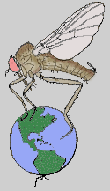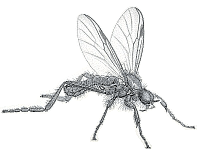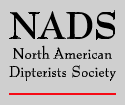
Diptera types in the Canadian National Collection of Insects
Home | Part 1 | Part 2 | Part 3 | Part 4 | Supplement

Part 1
Nematocera
Cooper, B.E. 1991. Diptera types in the Canadian National Collection of Insects. Part 1. Nematocera. Agriculture Canada, Research Branch, Publication 1845/B. ISBN 0-660-55684-7. 113 pp.
View the PDF file of Part 1
Abstract
Type material of the nematocerous Diptera housed in the Canadian National
Collection, as of 31 December 1987, is cataloged. The collection contains
654 holotypes, 188 associated allotypes, 5 allotypes, 36 lectotypes, and
1 neotype. Fifty-two species are represented by syntypes, 423 by paratypes,
and 40 by paralectotypes. Reference to the original description of each
taxon is cited. Label data associated with the specimens are fully quoted,
except in the case of paratypes and paralectotypes. A bibliography and
an index to named taxa are provided.
Introduction
Primary types are in reality the property of science, and institutions
that house them have a special obligation to ensure their safety, their
permanent care, and their availability for research. Article 72G(4) of
the International Code of Zoological Nomenclature recommends
that every institution should "publish lists of name-bearing types
in its possession or custody" as an institutional responsibility.
This book, the first in a continuing series, seeks to implement this recommendation.
The early history of the Canadian National Collection of Insects and Arachnids (CNC), which officially began in l9l4, was first compiled by J.H. McDunnough (l926). Dr. McDunnough was appointed as chief of the Division of Systematic Entomology in l9l9 with special charge of the CNC. At that time the classified collection of Diptera consisted of l00 drawers. In September l922 he secured the appointment of C.H. Curran and placed him in charge of Diptera. In l928 Curran left the CNC to join the staff at the American Museum of Natural History in New York. Following his departure little progress was made on the development of the Diptera section until G.E. Shewell was brought on staff in l937. By that time the Diptera collection consisted of five insect cabinets containing 250 drawers. With the onset of the Canadian Forest Insect Survey in l936, and the Northern Insect Survey in l948, the CNC, including the Diptera collection, grew very rapidly. By l957 the Diptera collection contained an estimated 600 000 pinned specimens (J.F. McAlpine in litt.). In l960, G.P. Holland reported that the CNC, including the Diptera collection, was growing by about l50 000 specimens annually (Holland l960). In June l978, the pinned collection was housed in 4670 drawers (J.F. McAlpine in litt.). At an average of 350 specimens per drawer, the approximate number then would have been l 634 500 specimens. At present it is estimated to contain l 900 000 specimens.
The rapid growth of the collection was correlated with appointments of additional research staff, namely, A.R. Brooks (l938--1948), J.R. Vockeroth (l949), J.F. McAlpine (l950), J.G. Chillcott (l952), J.A. Downes (l953), D.M. Wood (l960), and D.R. Oliver (l962). With the closing of Agriculture Canada's Medical and Veterinary Research Laboratory at Guelph, Ont. in l964, B.V. Peterson and H.J. Teskey were transferred to the Diptera Section in Ottawa. The most recent appointments are A. Borkent (l982) and J.M. Cumming (l986). Other internationally known dipterists who worked for shorter periods in the Diptera Section of the CNC are W.R. Thompson (Tachinidae), W. Hennig (Acalyptratae), H.C. Huckett (Muscidae and Anthomyiidae), and K.A. Spencer (Agromyzidae).
Several private collections of Diptera have been incorporated into the CNC. The most notable of these are the tachinid collections of H.J. Reinhard (l968), W.R. Thompson (l969, from Trinidad), and L. Mesnil (l970, l985), as well as the F.M. Hull collection of Diptera (l973, l98l), a synopic collection of K.A. Spencer's world Agromyzidae (l976), the C.B.D. Garrett collection of Diptera (l96l), the N.I. Baranov collection of Simuliidae (l954), and a portion of the F. Schmid collection of Thaumaleidae (l964).
The CNC Diptera collection also contains a large amount of exotic material, most notably, major United States collections from California (Mohave Desert and other localities), Texas, Colorado, North Carolina (Blue Ridge Mts.), Florida, and Hawaii. Equally important are the Neotropical collections, made mainly by L. Pena and F. Plaumann from Chile, Ecuador, Peru, Brazil, Argentina, and Juan Fernandez Islands; in addition there are large collections from the West Indies and Mexico. Other areas that are well represented include Nepal, India, Sri Lanka, Australia, New Zealand, New Caledonia, and the H. Falke collection from Uganda. A relatively large collection of European material has been built up over the years through collecting expeditions, purchases, and exchanges. An exchange program with the late A.A. Stackelberg of the Zoological Institute, Leningrad, has resulted in a valuable collection of USSR material.
In this book all nematocerous Diptera types in the CNC have been cataloged
through 31 December l987. In general, the catalog follows the format of
Arnaud (l979). Each entry is arranged alphabetically by family, genus,
and species. All species are cited under the original combination in the
following format: sex, actual year of publication, abbreviated reference
to the journal of the original description with "intended" year
of publication, volume and number(s), relevant page, figures, and plate
numbers, followed by the country in capital letters from which the holotype
was collected. For holotypes, allotypes, lectotypes, neotypes, and syntypes
all label data associated with the specimen are cited in full. A diagonal
line is used to separate the information given on separate labels. In
some instances for clarification, additional information not provided
on the label is enclosed in square brackets. For paratypes and paralectotypes
the number of specimens is given, followed by provincial or state records
for Canada and the United States (and country in brackets if different
from that of the holotype) or by country for all other regions. Remarks
include condition of the type or parts missing, designation of lectotype,
and other important information pertinent to the type-specimen or type
series. All previously unrecorded types have been assigned CNC type numbers
during the course of this cataloging. In the families Chironomidae, Ceratopogonidae,
Simuliidae, and Scatopsidae most of the type material is preserved either
on slides, in alcohol, or pinned and is so indicated. Unless otherwise
indicated, the remaining families have pinned type material. All species
are arranged in the index by the specific name, followed by the original
generic name and author. A complete bibliography is also provided.
First published on the NADS website on 28 March 2003
Last update: 29 May 2006
J.E. O'Hara



